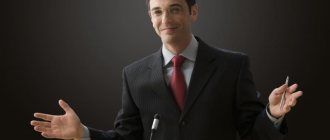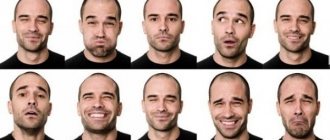So, again about the symbolism of the body. We will talk about the symbolism of gestures.
But first, a little theory. Nowadays it is customary to call communication communication. When communicating, people use two types of communication: verbal and non-verbal.
Verbal - (from the Latin word oral, verbal speech), that is, communication through speech, tempo of speech, changes in the pitch and tone of the voice, rhythm, timbre of the voice, intonation, diction of speech, phrasal and logical stress.
Of course, the meaning of words and phrases embedded in them is of great importance. In speech, an important role is played by the accuracy of the use of the word, its expressiveness and accessibility, the correct construction of the phrase and its intelligibility, and the expressiveness of the words. An important role is played by the expressive qualities of the voice, characteristic sounds: laughter, hemming, crying, whispering, sighs, coughing, pauses. Nonverbal (non-speech) communication is communication without the use of words, through gestures, facial expressions, pantomimes, and changes in the space of communication. The human body becomes the instrument of such communication.
Non-verbal is “body language”. The ability to read nonverbal cues is essential to effective communication. Psychologists have found that from 60 to 80% of communication is carried out through non-verbal means of expression, and only 20-40% of information is transmitted through verbal means. Through combinations of postures, facial expressions, hand and finger movements, a person can transmit a total of about 700 thousand different signals. This is much more than the vocabulary of any language.
We inherited non-verbal language in the process of human biological development. Culture has made its contribution to the development of body language.
The science of nonverbal communication is divided into kinesthetics, takesics and proxemics.
Kinestics - studies body language, all body movements that form non-verbal communication: facial expressions - movements of the facial muscles, gestures, pantomimes - movement of the whole body; poses, posture, bows, gait.
Takesika - studies touch gestures.
Semiotics - the science of the meaning of signs
Proxemics is the science of the location of people in space during communication and the distance zones during human contact.
In short, there are several types of zones - distances at which a person prefers to stay from the people around him.
- intimate zone (15-45 cm), only close, well-known people are allowed into this zone. Intrusion into an intimate area during communication is always perceived by the interlocutor as an attack on his integrity;
- personal or personal zone (45-120 cm) for normal conversation with friends and colleagues;
- the social zone (120-400 cm) is usually observed during official meetings in office premises with people whom they do not know very well;
- public zone (over 400 cm) implies communication with a large group of people - at meetings, in a lecture hall, at a rally, etc.
Of all the many areas related to non-speech communication, we will be interested in kinesthetics, namely gestures.
Every day we use dozens of gestures, almost without thinking about their meaning. The term “gestures” is understood as movements of the arms or hands, but is often used to refer to all body movements, including facial expressions and pantomimes. The term “gesture” is used to refer to the actual movements of the hands.
There are many classifications of gestures. Each researcher proposed his own classification scheme. Ekman and Friesen proposed the following “alphabet” of gestures:
Gestures-illustrators;
Gesture adapters/manipulators;
Gestures logos/symbols;
Gestures of emotions;
Gesture controls.
Illustrative gestures are descriptive and pictorial gestures that accompany speech and lose meaning outside the speech context (gestures indicating the size, shape of an object, spatial location of the object, etc.)
Such gestures include pointing your thumb back. “This is where you sit with me” - tapping the back of the neck with the edge of the palm. “Fed up”, “fed up” - a horizontal movement across the front of the neck with the edge of the palm. Is it possible to carry out the orders: “Open that window”, “Don’t take this book, take that one over there” if they are pronounced without a gesture? It is forbidden! In such situations, a pointing gesture is required.
With it, the speaker identifies some object from a series of homogeneous ones, shows a place - next to, above, above us, there, emphasizes the order of occurrence - in turn, through one.
Iconic gestures are used in cases
- if there are not enough words to fully convey the idea; - if words alone are not enough for some reason (increased emotionality of the speaker, lack of self-control, lack of composure, nervousness, uncertainty that the addressee understands everything); - if it is necessary to enhance the impression and influence the listener in an additional and visual way. However, when using figurative gestures, one must observe a sense of proportion: these gestures cannot replace the language of words.
Gestures - adapters/manipulators - help our body adapt to the environment around us. These can be: scratching, twitching of individual parts of the body; touch, partner; stroking, fingering individual objects at hand (pencil, button, etc.).
They resemble children's reactions and appear in situations of stress, excitement, and become the first signs of anxiety. So, if a person is upset, he can tug at his earlobe or clothes, and in difficult situations, he can scratch the back of his head. Touching the lower lip means that a person is thinking before making a decision.
Emblem gestures or symbols are unique substitutes for words or phrases or concepts in communication. These include, for example, the American symbol “OK,” which is quite common today in many countries around the world, meaning “everything is fine,” “everything is in order.”
1.
Sometimes you can insult a person with a symbolic gesture by declaring that your interlocutor is a stupid person, a mug, a cuckold, a bungler, etc.
Other symbolic gestures are even more limited by the boundaries of a particular culture or locality, and this specificity can manifest itself in two ways. Firstly, to denote a concept in one culture there may be a certain symbol, while in another there is no such symbol at all.
Gesture symbols include various salutes - gestures that signify belonging to a particular political or social organization. Sometimes a gesture can indicate nationality.
Gestures - emotions - facial expressions or gestures with the help of which one or another emotion is conveyed. Gestures that convey various shades of feelings are called emotional. Some of them are fixed in stable combinations, since such gestures have become generally significant. For example: beat yourself in the chest, hit the table with your fist, slap (hit) yourself on the forehead, turn your back, shrug your shoulders, spread your arms, point to the door. If you see a person (of any skin color) clutching his head, you will think that he has made a mistake, and you will be right. "What have I done!" - says this gesture.
All people, regardless of race, culture or gender, express anger, contempt, disgust, fear, joy, sadness and surprise in exactly the same ways.
Regulatory gestures are gestures that express the speaker’s attitude towards something. They express a prohibition, a request, a demand, regrets, permission, and contact. These can be gestures of approval and disapproval, disagreement and agreement, gratitude, gestures expressing sympathy, gestures of encouragement. These include a smile, a kiss, a nod, and a handshake.
A handshake is a traditional, symbolic gesture of greeting or concluding a transaction. It was believed that in this way friendly intentions were demonstrated - there was no weapon in the hand.
And in sports, a handshake symbolizes equality and respect for an opponent. Researchers have formulated a range of handshakes that signal the wide range of emotions conveyed by these gestures.
And a finger raised up indicates that the person is going to say (or is saying) something moralizing, and wants to draw attention to it.
The gesture of shaking a finger, warning of prohibition, dissatisfaction or unacceptable behavior, is known to many peoples. But in different countries the movements are slightly different. In our case, the threatening finger moves from the reproach to the culprit, and the entire hand is involved in the movement. And in Europe, the finger moves from side to side, like a metronome.
Threatening gestures: swinging a fist, showing a fist - also belong to the category of regulators. Of course, this classification does not exhaust all the variety of gestures. It’s difficult to say to what category formal gestures should be classified: curtsey, kneeling, kissing hands, bowing, applause, raising a hat.
But there are also artificial sign languages that have little relation to speech:
gestures designed for people with hearing impairments;
pantomime gestures;
ritual gestures;
professional sign languages; teasing gestures;
military salute;
gestural visual systems of theater and cinema languages, dance languages
https://kommersant.ru/doc/254914
https://blogs.privet.ru/community/lie.to.me.
https://ru.wikipedia.org/wiki/%D0%9D%D0%B5%D0%B2%D0%B5%D1%80%D0%B1%D0%B0%D0%BB%D1%8C%D0 %BD%D0%BE%D0%B5_%D0%BE%D0%B1%D1%89%D0%B5%D0%BD%D0%B8%D0%B5
https://www.oracle-today.ru/articles/24621/
https://images.google.com.ua/imgres?q=%D0%B6%D0%B5%D1%81%D1%82+%D0%B4%D0%BB%D0%B8%D0%BD% D0%BD%D1%8B%D0%B9+%D0%BD%D0%BE%D1%81&hl=ru&biw=1280&bih=882&gbv=2&tbm=isch&tbnid=ayT653S3quNOlM:&imgrefurl=https://www.barbariki.ru/index. php%. 15231991980908963904&page=5&tbnh= 158&tbnw=173&start=111&ndsp=27&ved=1t:429,r:25,s:111&tx=107&ty=87
https://sekretwomen.mirtesen.ru/blog?t=%D1%8F%D0%B7%D1%8B%D0%BA+%D0%B6%D0%B5%D1%81%D1%82%D0%BE %D0%B2
https://www.luckymojo.com/manocornuto.html
https://balkany.net/o-serbii-po-russki/pro-tri-paltsa.html
Foley J. Encyclopedia of signs and symbols. M., 1997;
The secret of character. Reading character by face. Kharkov, 1996;
Papus. Practical magic. M., 1998.
Lit.: Bayburin A.K., Toporkov A.L. At the origins of etiquette. Ethnographic essays. L., 1990;
https://deja-vu4.narod.ru/Kukish.html E. E. Levkievskaya Slavic antiquities. Ethnolinguistic Dictionary, ed. N.I. Tolstoy. T. 3. M., 1994, p. 26-27. https://slovari.yandex.ru/~%D0%BA%D0%BD%D0%B8%D0%B3%D0%B8/%D0%A1%D0%B8%D0%BC%D0%B2%D0 %BE%D0%BB%D1%8B,%20%D0%B7%D0%BD%D0%B0%D0%BA%D0%B8,%20%D1%8D%D0%BC%D0%B1%D0 %BB%D0%B5%D0%BC%D1%8B/%D0%96%D0%B5%D1%81%D1%82%D1%8B/
https://opp.kz/forum/index.php?topic=13825.0
https://www.srpska.ru/article.php?nid=6115
https://religion.ng.ru/style/2001-08-22/8_ustashi.html
https://www.liveinternet.ru/users/3048019/page3.html
https://ru.wikipedia.org/wiki/%D0%9F%D1%80%D0%B8%D0%B2%D0%B5%D1%82%D1%81%D1%82%D0%B2%D0 %B8%D0%B5_%D1%82%D1%80%D0%B5%D0%BC%D1%8F_%D0%BF%D0%B5%D1%80%D1%81%D1%82%D0%B0 %D0%BC%D0%B8_%28%D1%81%D0%B5%D1%80%D0%B1%D1%81%D0%BA%D0%BE%D0%B5%29
https://slovari.yandex.ru/~%D0%BA%D0%BD%D0%B8%D0%B3%D0%B8/%D0%91%D0%A1%D0%AD/%D0%9C% D0%B8%D0%BB%D0%BE%D1%88%20%D0%9E%D0%B1%D1%80%D0%B5%D0%BD%D0%BE%D0%B2%D0%B8% D1%87/
https://ru.wikisource.org/wiki/%D0%AD%D0%A1%D0%91%D0%95/%D0%9A%D1%80%D0%B5%D1%81%D1%82% D0%BD%D0%BE%D0%B5_%D0%B7%D0%BD%D0%B0%D0%BC%D0%B5%D0%BD%D0%B8%D0%B5
https://rsn.station.ru/community/blogs/senseisekai/archive/2011/06/28/272330.aspx
ru.wikipedia.org/…/%D0%9A%D0%BE%D0%BB%D1%8E%D0%BC%D0%BD%D1%8B
rusnovosti.station.ru/…/269147.aspx
https://ru.wikipedia.org/wiki/%D0%9D%D0%B0%D1%86%D0%B8%D1%81%D1%82%D1%81%D0%BA%D0%BE%D0 %B5_%D0%BF%D1%80%D0%B8%D0%B2%D0%B5%D1%82%D1%81%D1%82%D0%B2%D0%B8%D0%B5
https://waffen.ucoz.ru/news/2009-07-21-2092
https://artclassic.edu.ru/catalog.asp?ob_no=13184
https://ru.wikipedia.org/wiki/%D0%9A%D0%BB%D1%8F%D1%82%D0%B2%D0%B0_%D0%B2_%D0%B7%D0%B0%D0 %BB%D0%B5_%D0%B4%D0%BB%D1%8F_%D0%B8%D0%B3%D1%80%D1%8B_%D0%B2_%D0%BC%D1%8F%D1%87
https://idelsong.livejournal.com/299916.html
https://vive-liberta.narod.ru/biblio/yamp_zhest.htm
https://ru.wikipedia.org/wiki/%D0%9A%D0%BB%D1%8F%D1%82%D0%B2%D0%B0_%D0%B2%D0%B5%D1%80%D0 %BD%D0%BE%D1%81%D1%82%D0%B8_%D1%84%D0%BB%D0%B0%D0%B3%D1%83_%D0%A1%D0%A8%D0%90
https://man-with-dogs.livejournal.com/385925.html
https://feldgrau.info/forum/index.php?topic=147.0
https://rumbur.ru/history/760-heil-hitler-ili-prosto-ziga
https://www.russdom.ru/node/1607
https://ru.wikipedia.org/wiki/%D0%93%D0%B5%D1%80%D0%BC%D0%B0%D0%BD%D0%BE-%D0%B0%D0%BC% D0%B5%D1%80%D0%B8%D0%BA%D0%B0%D0%BD%D1%81%D0%BA%D0%B8%D0%B9_%D1%81%D0%BE%D1% 8E%D0%B7
https://varjag-2007.livejournal.com/438536.html
https://varjag-2007.livejournal.com/371695.html#cutid1
https://www.slovoborg.ru/definition/%D1%83%D0%B4%D0%B0%D1%80%D0%B8%D1%82%D1%8C+%D0%BF%D0%BE+%D1 %80%D1%83%D0%BA%D0%B0%D0%BC
https://glossword.info/index.php/term/,6ea3ac6f59585aae957159a667ac9b92577064a954a19457957159a66768a4926a676bac6ba5b0555957536f69585caaa9a6ac6868b1ac71596a 989d5e689b6a575f58.xhtml
https://dic.academic.ru/dic.nsf/dic_synonims/266421/%D1%83%D0%B4%D0%B0%D1%80%D0%B8%D1%82%D1%8C
https://phraseology.academic.ru/13128/%D0%A3%D0%B4%D0%B0%D1%80%D0%B8%D1%82%D1%8C_%D0%BF%D0%BE_%D1 %80%D1%83%D0%BA%D0%B0%D0%BC
https://www.knigge.ru/voenni_etiket.html
What is kinesics?
Kinesics in psychology is a science that studies the totality of gestures, facial expressions and pantomimes that accompany the process of human communication. People do not control their body movements as much as they control their words, so observing the interlocutor’s facial expressions and gestures makes it possible to obtain additional information. Often, with gestures and facial expressions, a person can express much more important information than what he is trying to convey in words.
There are other branches of psychology that study the characteristics of nonverbal communication. This includes proxemics, which studies the spatial relationships of people, and takeshika, which studies the language of touch.
The power of body language
More than one book has been written about the power of body language. It should be noted that incredible opportunities sometimes open up for the owner of this power of knowledge. This can be compared to magic or sorcery. But no, it's much more effective!
Just imagine: using positive body language cues can help you get what you want. For example, it will help you get a job, sell or buy something profitably, win an argument, or easily start a relationship. But you shouldn’t fall into euphoria ahead of time, because there are also negative signals that can give you away and prevent you from achieving your desired goal.
The fact is that it is very difficult to control your own body language (although it is possible if you engage in regular training and acquire the necessary skills). You may use some signs, but your true intentions will also become clear to people who know non-verbal language.
Important! Be careful when judging someone else's body language. You must always remember: any gesture or facial signal can have the opposite meaning for different people.
Facial expressions
Voluntary and involuntary movements of the facial muscles are called facial expressions. Facial expressions are an important element of nonverbal communication. Movements of the facial muscles help a person more fully convey information to the interlocutor, demonstrate his mood and attitude to the topic of conversation. With the help of facial expressions, people express a basic set of emotions - joy, sadness, anger, fear, surprise, disappointment. A smile alone can have many meanings. She can be joyful, tense, contemptuous, polite, sad, etc.
Since a person is able to voluntarily move his facial muscles, he can consciously enhance or, conversely, restrain the expression of emotions. Therefore, for a more complete assimilation of information, it is necessary to take into account the words that the interlocutor speaks and his facial expressions.
Sight
The look is closely related to facial expressions. Eye contact is very important during a conversation. By the look of the interlocutor you can understand whether he is telling the truth or lying, whether he is interested in the conversation, whether he feels confident or embarrassed.
The more relaxed the conversation participants feel, the more often their views intersect. An interlocutor who hides his eyes does not inspire confidence. The pupils can also tell you a lot. Pupil dilation indicates that the person is in a good mood, excited, or interested in a conversation. Constriction of the pupils, on the contrary, indicates a bad mood.
Limitation
Most cultures have many restrictions on touching. If we make a list of touches, we will see that in different cultural strata they are treated differently.
For example, a slap in the face is an act of aggression, and a playful pat on the back, even a very sensitive one, is perceived by old friends as a sign of friendship. The acceptable level of touching varies greatly from culture to culture. In England, for example, interlocutors very rarely touch each other. At Cambridge, it is customary for students to shake hands twice a year - at the beginning and at the end of the academic year. In Latin America, on the other hand, the frequency of touching is very high.
Handshake. An indispensable attribute of any meeting and farewell is a handshake. It can be very revealing, especially its intensity and duration. A handshake that is too short, limp and dry may indicate indifference. On the contrary, a long handshake and too wet hands indicate strong arousal. A slightly longer handshake, as well as a smile and warm gaze, demonstrate friendliness. However, you should not hold your partner's hand for too long, otherwise he may feel discriminated against (as if he is trapped).
You can give this gesture different meanings by using different inversions of the palm. If your hand grasps the other person's hand with the palm facing down, it is a forceful handshake. This handshake indicates that you want to dominate the communication process with your partner.
When you hold your hand palm up, it is a submissive handshake. This is necessary in situations where you need to give the other person the initiative or make him feel like he is the master of the situation.
A handshake in which the partners' hands remain in the same position means that both partners have a feeling of respect and understanding for each other.
A straight, unbent handshake, like an excessive handshake, is a sign of disrespect. Its main purpose is to maintain distance and remind people of inequality.
Shaking with your fingertips is similar to shaking with a straight, uncurled arm, but instead of a hand, the palm contains fingers.
The goal of the initiator of this handshake is to keep the communication partners at a comfortable distance.
The gesture called “glove” means that the initiator is honest and can be trusted. This gesture is only used for people who know each other well. A handshake with both hands expresses sincerity or depth of feeling towards a partner. To convey excessive feelings, the left hand is used, which is placed on the partner’s right hand.
The depth of sensation depends on where the hand is placed. If it is located on the partner's elbow, it expresses more feelings than if it is located on the wrist. When the hand is placed on the shoulder, it expresses more feelings than when it is placed on the forearm.
Gestures and postures. In the practice of business interaction, there are several basic gestures that reflect the internal state of a person. A. Alonso, a Cuban ballerina, writes about how these signs are deciphered in a woman’s behavior: “The strength of a woman is not in the beauty of her face. It is through plastic surgery that a woman’s beauty is revealed. A woman with a graceful gait, measured gestures, straight and collected on the street and at home, always makes a good impression. On the contrary, if she moves awkwardly, slouches, and her movements are careless - lazy or too nervous - when we see the disharmony of the human body, we involuntarily think that this person is not very attractive, careless in housekeeping and work, or is too nervous, capable of rash actions.
In fact, hand and body movements convey a lot of information about a person.
First, they manifest themselves in the state of the body and immediate emotional reactions. This allows you to assess a person’s temperament (strong or weak reactions, fast or slow, sluggish or lively).
Secondly, body postures and movements express many character traits, the degree of self-confidence, tension or relaxation, caution or impetuosity.
A person's social status is manifested in his posture and movements. However, expressions such as “walking with your head up,” “straightening your shoulders,” or, conversely, “standing on bent legs,” also express a certain psychological state of a person.
Thirdly, posture and gestures reveal the cultural norms a person has internalized.
For example, a well-mannered man will never talk while sitting next to a standing woman, no matter how he evaluates her personal merits.
Fourthly, purely conventional symbolic meanings are attributed to gestures and postures. Thus, they are able to convey accurate information.
Gestures of openness show sincerity and a willingness to speak openly. This group of signs includes the “open hands” and “unbuttoning jacket” gestures.
The “open hands” gesture involves the person you are talking to extending their hands forward towards you, palms up.
This gesture is especially common among children. When children are proud of their achievements, they openly show their hands. When children feel guilty, they hide their hands either behind their backs or in their pockets.
With this gesture you show your willingness to seek contact.
Gestures
Gestures are various movements of the hands and head. Gesticulation during a conversation, as well as facial expressions, carries a lot of information. The more active the conversation, the more intense the gesticulation of its participants becomes.
There are several main types of gestures:
- Communicative - gestures that people use to greet, say goodbye, attract attention, etc.
- Modal - with their help, a person expresses his attitude towards the interlocutor or situation (approval, disapproval, satisfaction, trust or distrust).
- Descriptive - gestures that are used only in the context of a specific conversation.
For representatives of different cultures, the same gestures can have completely different meanings. For example, greetings are expressed differently among different peoples: with a nod, a bow, a raise of the hand, a kiss, a handshake, and even a collision of heads. For some nationalities, it is customary to sniff each other, hit a friend on the head or shoulder with a fist, bend your arms in a certain gesture, and much more.
As a result, misunderstandings often arise between representatives of different cultures. To foreigners, many gestures seem strange and unusual. For example, in many countries the main greeting gesture is a handshake. But representatives of some nations consider physical contact between strangers unacceptable.
Basic communicative gestures, their meaning and origin
As you know, studying an interlocutor (communication partner) with the help of his gestures, facial expressions and posture belongs to the field of kinesics. Let's look at some of these kinesics.
All over the world, the basic gestures of communication do not differ from each other. When people are happy, they smile; when they are sad they frown; when they are angry they have an angry look. The shrug is a good example of a universal gesture that means a person doesn't know or doesn't understand what they're talking about.
Dressing gestures - straightening one's hair, showing a woman's wrist, straightening a man's tie, etc. - are almost definitely considered a sign of intimate affection for the interlocutor (interlocutor) and even sexual attraction. However, in the case of demonstrative individuals, such gestures mean, first of all, an attempt to attract attention to oneself or simply constant concern for one’s appearance. Regardless of who is nearby, demonstrative women constantly shake their hair, lick their lips, etc. - and this is not “I like you,” but “Look how beautiful I am.” That is why, as mentioned above, such ladies become victims of violence - especially if their interlocutor turns out to be a direct man, who has also read books about the meaning of such gestures...
A men's tie is a separate issue. A demonstrative man, when adjusting his knot, most often just wants to put on his interlocutor’s tie: so that she can appreciate the pattern, texture, color, and so on. And she will also mistakenly believe that the man is giving her sexual signals by doing this..... On the other hand, a down-to-earth man will only make sure that his tie is strictly in the middle - and he will adjust this tie specifically on the doorstep of the office manager . (What kind of sex is this!) And an indecisive man adjusting his tie may simply be showing the interviewer a somatization of his inner tension: he just felt literally crushed by the words he was about to hear!
The intertwined fingers gesture, especially with the palms half open towards you. The usual interpretation of the entire group of “intertwined” gestures is hidden hostility, an internally negative attitude towards the interlocutor, disappointment, and the like. However, this reading probably applies only to the demonstrative type. But on the other hand, such a gesture is very typical for doubting people, especially in public. Can you imagine how listeners who read Pisa would appreciate such a lecturer? And indeed, the Doubter now holds in front of him a kind of “virtual cheat sheet” - it’s not for nothing that this gesture is sometimes called an “open book.” In front of an audience that is especially important to him, it is important to have at least such a pseudo-guarantee. And this gesture during a speech means that he is saying very important things and wants to be understood correctly. And another possible interpretation of this gesture during his speech is that he wants to emphasize that there is a certain logical connection in his speech. Crossed fingers in this case are precisely its symbol!
For an esthete, such a gesture means nothing: after all, his hands are constantly dangling on their own. Therefore, during an important conversation, he can simply clasp his fingers so that his hands do not interfere. But to the immediate, intertwined fingers are often a redirection of aggression (and this means that he not only actively rejects your words or actions, but is also ready to kill you on the spot).
The arms folded gesture (the so-called Napoleon pose) is usually interpreted as a barrier, an attempt to separate oneself from others. This is also not entirely true. In this gesture, for example, the Demonstrative or Spontaneous Lady often raises her chest and seems to bring it forward. But the Demonstrative does this to attract the attention of the interlocutor to this area of the body (in fact, this is a gesture of sexual attraction, not a barrier), while the Direct can thus signal its aggression and readiness to “attack”!
Pose
The postures a person takes during communication can also tell a lot. The position of the body is least subject to conscious control, therefore the pose of the interlocutor speaks about his true state much more eloquently than facial expressions and gestures.
This happens because people are taught from a very early age to control their emotions and facial expressions, but are not taught to control their posture. Therefore, it is the body position that the interlocutor takes during a conversation that best reveals his true feelings. During the communication process, depending on the direction the conversation has taken, the postures of its participants can change significantly. This is also important to consider when transferring business or personal information.
Psychologists distinguish three main groups of postures:
- Openness or closedness. If a person is inclined to communicate, he smiles, his posture is relaxed, his palms are open, his torso is turned towards the interlocutor. If a person is closed, he crosses his arms and legs, leans away from the interlocutor, interlocks his fingers.
- Dependence or dominance. A person striving for dominance can hover over his interlocutor, pat him on the arm, shoulder, or look down on him. Dependence is expressed by looking up and lowering the head.
- Harmony or opposition. Harmony is expressed in a posture that matches the position of the interlocutor. Confrontation manifests itself in the form of clenched fists, a forward shoulder, a militantly raised chin, and hands placed on the sides or hips.
The problem of gesture recognition in national cultures
With the intensification of international communication, the question arises not only of the need to study foreign languages, but also of the importance of analyzing gestures in the context of another culture. Insufficient attention to the peculiarities of the perception of gestures in another culture leads to misunderstanding in the communication process, including in negotiations and in PR campaigns of transnational brands. Examples of discrepancies in the understanding of gestures in Russian culture and other cultures: An open pose among women in Europe and America is considered decent and is perceived positively, but in Japan it is considered immoral; A smile in American culture is a familiar element of any communication; in Russia, people smile when communicating only if their partner evokes positive emotions; The joined index finger and thumb mean "Okay" in Westernized cultures, but in France, for example, the gesture means "zero" and in Brazil it is considered a sexual insult. This led to a scandal when President R. Nixon gave a speech in Brazil and showed this gesture; A typical “calling” gesture, when the hand is raised to chest level with the fingers pointing upward and making a rocking motion towards oneself, in Arab countries or Japan can be interpreted as a demand to leave; The thumbs up, which in Western cultures is a sign of approval, is considered offensive in Arab countries.
Gait
Gait is the style of movement of a person. This includes the width and rhythm of the step, movements while walking, the position of the torso and head. Gait includes components that can tell about a person’s physical and mental well-being, the characteristics of his character and temperament.
A heavy gait is characteristic of people who are in a bad, depressed mood; a light gait, on the contrary, is characteristic of optimists. An insecure person walks with his head down and his back hunched. Confident – holds himself upright with his head held high and shoulders back.
Active and proactive people walk quickly and confidently, often swinging their arms while walking. Secretive people keep their hands in their pockets or behind their backs. A person engaged in mental activity walks slowly, with a thoughtful look. People of a demonstrative nature lift their chins high, walk on straight legs, trying to emphasize their superiority.
Suspicion and secrecy
— The “hand covers the mouth” gesture before or during a statement - a person wants to hide his position on the issue under discussion; - Looking away means distrust; - Legs (or the whole body) directed towards the exit - evidence of the desire to end the meeting, conversation or what is happening. If the majority of listeners in the audience or at a meeting take this position, this is a signal that the event needs to be completed; - Stretching or lightly rubbing your nose (usually with your index finger) is a sign of doubt. This gesture is often used by speakers when they are unsure how to approach a subject or doubt the audience's reaction.
Most common gestures
There are a great many gestures with which a person can express the whole gamut of feelings. As an example, we can consider the most common gestures and their meaning.
- Touching the ear or scratching it indicates that the person does not like what the interlocutor is talking about.
- Propping your chin indicates boredom and a desire to end the conversation as quickly as possible.
- Stroking or scratching the chin indicates thought and reflection.
- Tapping your fingers or other objects on the table, glancing at your watch, tapping your feet on the floor, or swaying your feet indicate impatience.
- Open palms and an unbuttoned jacket or jacket indicate a willingness to communicate and openness.
- Crossing arms and legs, a closed posture indicates distrust or reluctance to communicate.
- Rubbing or scratching the neck indicates doubt and uncertainty.
- Hands placed behind the back or behind the head indicate the interlocutor’s desire to show his superiority.
- Removing and wiping glasses, biting the temples indicate reflection.
- Covering your mouth with your palm means secrecy or lying; the interlocutor is not saying something or is telling deliberately untrue information.
- Hands in pockets indicate secrecy or reluctance to participate in the conversation. If the thumbs protrude outward from the pockets, the interlocutor seeks to dominate.
There is a lot of literature devoted to means of nonverbal communication. By studying the meaning of facial expressions, gestures, postures and glances, you can learn to better understand people, see their true feelings, distinguish truth from lies in conversation. This knowledge will help you significantly improve your life and achieve greater success in your career and interpersonal relationships.
A little theory
Gestures - words
I wrote above that gestures cannot be perceived as words. I generalized too much, I confess. There are such gestures.
They are like that, “negotiable” - they somehow agreed that a thumbs up means “okay”, “I beg” means folded hands in prayer, and the outstretched index and middle finger means “victory”. And the raised average... well, you know.
And also all sorts of “shoot yourself”, “strangle”, “hang yourself”, simply symbolizing the corresponding action.
Oksana Fedorova: - This is how it got me.
Kinesthetic and visual gestures
Conventionally, gestures can be divided into visual and kinesthetic. Visual pointing gestures - the speaker shows where the image he is describing should be located. Or points to a real person or object: - This car looks great.
Posters with kinesthetic and visual gesture.
Kinesthetic gestures convey state, tension, and show a specific action.
Since visual gestures give direction, they are mainly used to indicate the position of the image. But the conveyed state - interesting, pleasant, sad, delightful - is conveyed by other non-verbal means - muscle tension, voice, facial expressions.
There are only a few evaluative things that can be conveyed using “purely” visual gestures, such as importance. Usually, the higher the image, the more important it is. And you can point to this image with your finger, palm and even your head. For kinesthetic gestures, the importance is rather conveyed by the level of muscle tone - palms, arms.
Fidel Castro and Saakashvili both talk about important things, but the first one has a more visual gesture, the important thing is somewhere at the top, while the second conveys importance only by muscle tension and facial expressions.
At the same time, it is clear that it will not be possible to absolutely clearly separate visual and kinesthetic gestures - if we move our hand, then there is at least some muscle tension. And the kinesthetic gesture at least shows something. Even more - for a gesture to be congruent, both “visual” and “kinesthetic” components must be taken into account. For example, if we are talking about something really important, there should be corresponding muscle tension. Otherwise there will be completely different messages.
Lenin and Stalin. Both talk about a big and important goal, but due to different muscle tone, the perception of this “important” is quite different.
So it’s probably more correct to talk about the “visual” and “kinesthetic” components of gestures. It’s just that if there is more of a “visual” component of a gesture, I will write about visual gestures, if there is a “kinesthetic” component, I will write about kinesthetic ones. This is simply a convenience of description.
Me, you, information
Gestures can show not only an assessment - important, interesting, bad - but also to whom this assessment applies. It is convenient to divide these messages into three groups - about yourself, listeners and information. This is the same example when, with the help of gestures, we indicate to whom the information relates.
- I'm important.
- You are important.
— This (information) is important.
Since we point, the gestures are visual .
Me, you, information.
Kinesthetic gestures, in this sense, are more impersonal - the assessment is shown, and what it refers to to whom or what can be understood either from words or with the help of visual gestures.
Illustrators and manipulators
Paul Ekman, an expert in calibrating lies (he was a consultant for the series “The Theory of Lies” and the main character seems to portray him) distinguishes two types of nonverbal messages - illustrators and manipulators. Illustrators, as the name suggests, help you better understand words, like pictures in a book. But manipulators report anxiety that a person wants to relieve. That is, a person gets worried and begins to rub various sensitive places in order to interrupt this feeling - neck, nose, ear, eyelid. Or objects on/in the body - rings, earrings, watches. Manipulators also include biting and touching lips.
Manipulators don't necessarily report lying; they report anxiety. But what the excitement is about - uncertainty, doubt, the desire to hide sexual arousal - this depends on the situation. So it is impossible to assign an unambiguous meaning to the manipulator.
Angelina Jolie: “You turn me on, but I’m trying to control myself.”
Milla Jovovich: - I'm worried.
Another thing is that when during a speech the speaker begins to rub his neck or twirl the ring on his finger, this can be perceived as lack of self-confidence or an attempt to lie. So it is a strong recommendation to watch your hands.
But at the same time, with the help of demonstrative manipulators, it is precisely possible to show “complex” feelings - for example, confusion from a “stupid” question or thoughtfulness.
Semyon Farada: - We need to think about it.
Leonid Parfenov: - Well, what a question!











